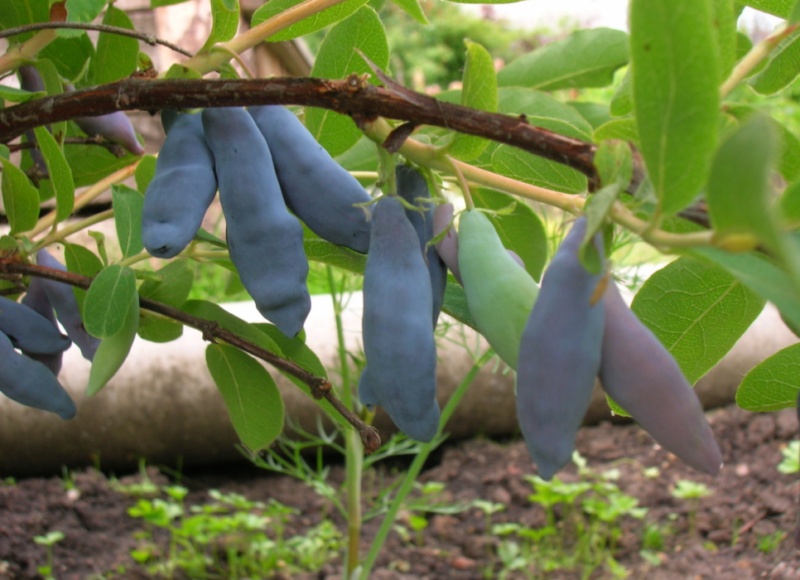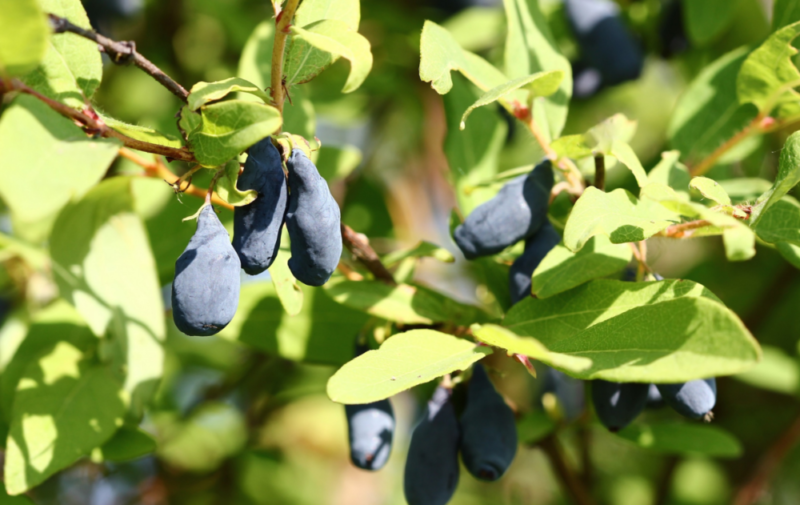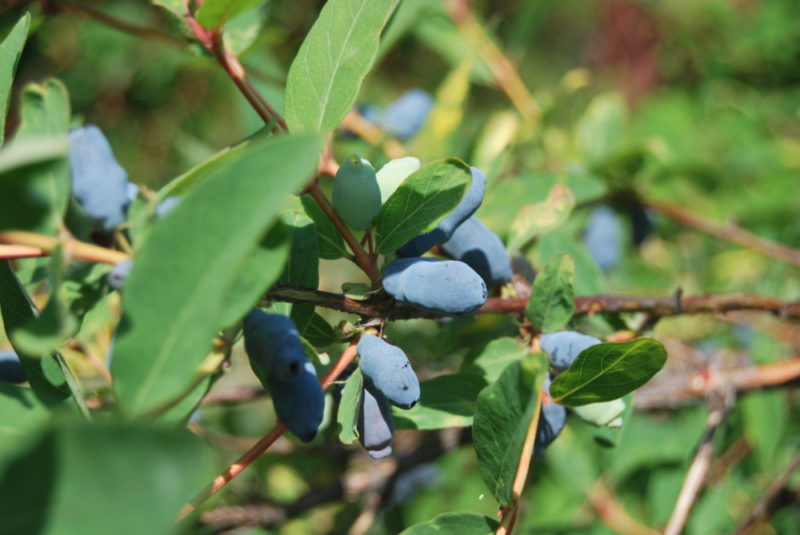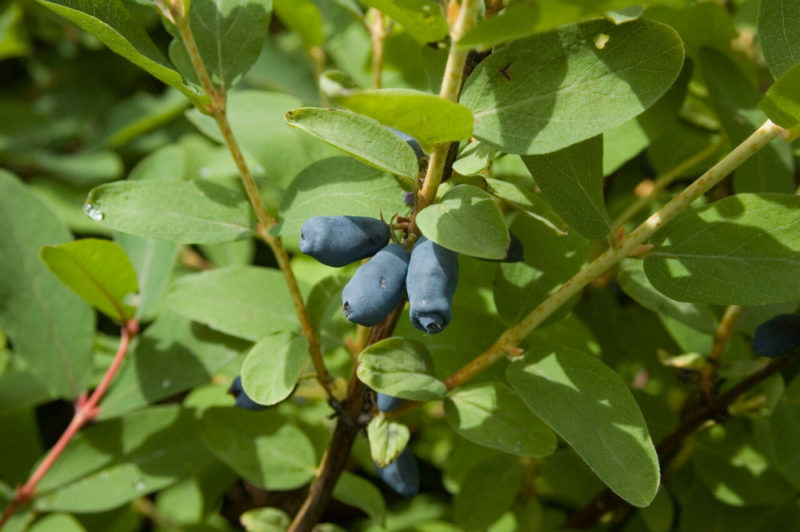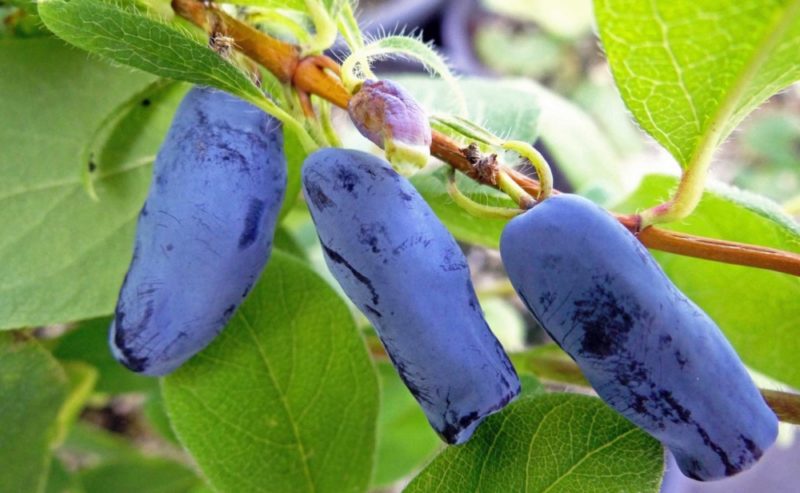Almost every garden has honeysuckle. It is frost-resistant and in any summer - whether it is hot and arid or cold and rainy - the crop will be excellent. It is for these qualities that the plant was loved by gardeners from all regions. More than 70 varieties of this shrub have been cultivated in the countries of the former USSR, and one of the most popular is the Leningrad Giant honeysuckle. In the description of the variety we will talk about productivity, taste, you will also learn how to properly plant honeysuckle and how to care for it.
Material Content:
Description of honeysuckle variety “Leningrad Giant”
The variety "Leningrad Giant" was bred by seed method. Kamchatka’s honeysuckle, which is wild growing, became its parent. Despite the fact that the ancestors of the Giant are the inhabitants of the forests, and their fruits are not so large, the variety has become one of the elite.
He is early ripe. The main advantage is the percentage of sugar, which can reach 8. The fruits are very sweet, devoid of bitterness, so the Leningrad Giant becomes the parent of other hybrids.
The berry is also valued for its size, one can reach a weight of up to 4 g, hence the name of the variety.
Giant can be grown in regions where few berry plants grow due to the harsh climate. This variety is adapted to frost, easily tolerates a drop in temperature to -40 degrees. Inflorescences are not afraid of spring frosts, buds and flowers are preserved even at -8. Also, the plant is not demanding for the presence of warm days during the period of active vegetation, it develops and bears fruit in any climatic conditions.
Bush height from 1.5 to 2 meters. Crohn is round, not thickened. The shoots are straight, green.Over time, the bark becomes brown, and on the trunk it cracks and can peel off, which is normal for any honeysuckle. Inflorescences consist of several bell-shaped flowers, their color is light yellow. The foliage is dark green, its shape is oval, elongated.
Fruits are elongated, with a rounded base. The color is dark blue, and a whitish waxy coating gives a bluish tint. The skin is soft, but dense, smooth. The surface of the fruit is slightly tuberous, and the flesh is juicy, tender, has a strong aroma and a sweet, slightly sour taste.
Productivity is high, in a year you can collect from one bush from 3 to 5.5 kg of delicious berries.
Fruiting starts from the third year after planting a seedling, and the Leningrad Giant reaches its maximum yield by the age of five, and keeps it up to 25-30 years.
An advantage of the variety is that when ripe, the berries do not crumble, like other honeysuckle, but continue to hang on the branches, waiting for the gardener's caring hand.
Outdoor landing
Honeysuckle planting can be arranged both in spring, in April and May, and in autumn. Mostly one-year-old seedlings are chosen, they must have a healthy root system, and buds on the branches.
Select a berry growing plot sunny, but still. The perfect place will be that of the fences. Honeysuckle soil loves fertile, black, does not tolerate sand. Pay attention to the pH of the soil, the optimum acidity is from 5.5 to 6.5, if higher, add lime to the ground.
Before planting, seedlings should be placed in the water for 1-2 days, so that they are nourished and straightened. Next, use secateurs to remove rotted and dried up areas, and treat the sections with charcoal.
While the honeysuckle is getting wet, you need to prepare holes for it in the selected area:
- Dig holes 50 cm deep and wide. Fill half the nutrient mixture of equal parts of chernozem, manure or compost, ash.
- Place the stem with the root in the hole, pour the same nutrient mixture that was taken to fill the pits, to the basal neck.
- Water well, if the soil is donkey, pour just black soil. Tamp, sprinkle with mulch, it will help maintain moisture and prevent weed grass from filling the area.
You can’t cut the shoots, you can only remove the dry twigs.
Deciduous Shrub Care
Edible honeysuckle "Leningrad Giant", like any other cultivated plant, needs care.
In the care, the bush is not whimsical, for the development and health of the honeysuckle, it is necessary to adhere to the following rules:
- Watering the newly planted cuttings is frequent, you need to irrigate the earth every time it starts to dry. In conditions of high humidity, the bush will take root faster.
- Honeysuckle from three years of age watered less often, only 1 time per week. But if drought sets in, then it will be possible to increase the amount of irrigation. Lack of moisture affects the taste of berries. Under one adult bush, it is recommended to pour 15 liters of water. And so that it does not flow past, make a trench with a few cm depth around the bush.
- It is advisable to water from a hose or watering can, honeysuckle likes to swim. But during the flowering period, pour water under the root, since the pressure of the water can wash away the pollen.
- Clean the weed.
- Loosen the soil after watering.
- Trim as follows.
Feed the bushes every year in several stages:
- In the spring, until the buds are full, pour the bushes with a solution of water with urea, add nitrogen-containing fertilizer.
- Before flowering, spray the bush with phosphorus fertilizer.
- In the fall, add 150-200 g of ash to each bush.
Further care for honeysuckle will be considered in more detail.
Pollination and pruning technology
The variety is self-fertile, it can bloom, but does not produce fruit ovaries, additional pollinators are needed.
Excellent yield will be if next planted the following varieties of honeysuckle:
- "Moraine";
- "Blue Spindle";
- "Blue bird".
Also, high yields depend on pruning.Young bushes up to 5 years old do not need a procedure, only dry shoots need to be cleaned.
But more adult specimens begin to strongly thicken the crown with abundant growth, therefore, you need to make haircuts twice a year:
- In the spring, sanitary pruning is needed, in which dry and weak branches are removed. The procedure is performed before budding.
- In the fall, the crown is thinned out. Truncated basal shoots, branches growing inland, old shoots that no longer give growth and fruits are cut. It is necessary to remove those branches that are in the depths of the crown, thickening it.
When the honeysuckle is 7 years old, it will be necessary to produce additional trimming bush rejuvenation once every three years. To do this, selectively remove thick shoots, leaving them only a few centimeters. In the future, from these hemp will appear fresh, young twigs.
Preparing the plant for winter
Shelter for the winter is only a young bush, which was planted this year. Any covering material of natural origin is suitable.
Starting next year, the honeysuckle will already be stronger, and will easily survive even the harsh winter without a “blanket”. The only thing that needs to be done before winter is cleaning near the trunks. Rake the mulch, foliage, and cutaway shoots aside.
If this is not done, then harmful insects will settle near the bush and with the advent of spring will begin to destroy honeysuckle.
Protection against diseases and pests
Honeysuckle "Leningrad Giant" is a descendant of wild berries, so it has high immunity to all diseases and pests.
But still, under conditions of high humidity and in the absence of sanitary scraps, the bush can overcome a fungal disease. If dark gray, brown spots began to appear on the foliage, this would mean that the bush was sick. To treat it, you need to urgently start using fungicides, they are sold in stores for gardening.
The lack of spraying the bushes during dry periods can lead to an attack of honeysuckle aphids or honeysuckle flies. Pests greatly affect the health of the culture, as they feed on its juice. Spray the bushes with insecticides, and then for prevention use a soap solution, dusting the leaves with ash and ash.
Another enemy of the crop is birds. During the ripening period, they can begin to eat berries. In order to protect your economy, throw nets on the bushes. Also, birds love to feast on the buds of the bush, this happens in the winter months, when birds can not get food. Cover the honeysuckle with metal grids or throw rag on the bushes. You can wrap the trees in burlap, through it the birds just will not get to the shoots.
"Leningrad Giant" is a popular variety of honeysuckle. Berries are useful for general health promotion, will help with hypertension. Also, the fruits are endowed with a diuretic property, which allows you to remove harmful substances and excess fluid from the body. Jam, compote, wine and juice from honeysuckle are very tasty, nutritious and healthy products. In them, as in fresh berries, there are many trace elements and vitamins that a person needs at any time of the year. Be sure to plant a Leningrad Giant honeysuckle in your garden if you have a garden!



